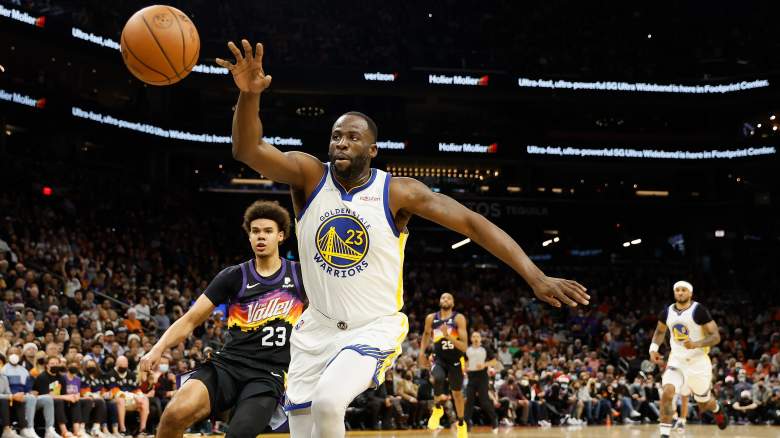
Getty Draymond Green chases a loose ball during game against the Phoenix Suns on December 25.
With Draymond Green in health and safety protocols for at least another few games, the Golden State Warriors will need to get creative in re-creating the production output of their All-Star forward.
During last night’s loss to the Denver Nuggets, the Warriors not only lacked Green’s trademark defensive versatility, but in large part his playmaking capabilities. They generated just 20 assists, when they usually average around 28, and playmaking became a by-committee concept.
Utilizing Depth
The Warriors greatly improved their depth during the offseason, and now might be time to stretch out the use of it, especially by extending the minutes of forward Nemanja Bjelica.
While Juan Toscano-Anderson got the start against Denver, Bjelica might be more suited to help kickstart what was a stagnant offense. The 33-year-old Serbian isn’t necessarily the same caliber of ball handler as Green, but his high per-minute assist rate and determined ball movement are assets that especially Stephen Curry and Andrew Wiggins – now back in the lineup – can use to play off of.
Further aiding the argument for Bjelica is the combination of his historically solid three-point shooting and rebounding. He’s canning 39.1% on his long-range shots and grabbing 4.0 rebounds in just 15.1 minutes (9.4 boards scaled to per 36 minute averages) on the season. Stretching Bjelica’s minutes into the mid-20’s during Green’s absence should give the offense the kick in the rear it needs.
Defensively, it’s a different story. Toscano-Anderson is a more switchy defender and offers a stronger physical frame, which he applies well on opposing players. However, with Wiggins now back, the Warriors should be able to survive defensively with Bjelica getting extra burn.
Of course, Bjelica won’t have the same ESP out on the court with Curry as Green. But really, who does?
Other notable options are Otto Porter Jr and Andre Iguodala. Porter adds spacing and an injection of offense, but isn’t much of a passer or shot-creator. Iguodala is a strong playmaker, but his 20.9% from behind the three-point line, and overall limited offensive contributions, can be problematic during dry spells.
Going Younger
There’s also the option of going younger with Jonathan Kuminga taking on more responsibilities. The rookie has seen his minutes increase as of late, and has generally responded well. Getting him more acclimated to the speed of the NBA game isn’t a bad idea, especially given the uncertainties of player availability due to health and safety protocols moving forward.
Kuminga is theoretically a fine bridge between what you’re getting from both Bjelica and Toscano-Anderson. He’s a switchy defender with great physicality, moves the ball quick and is a developing scorer, despite not being much of a shooter yet, hitting just 29% from outside.
He won’t necessarily generate a lot of assists – he has just seven on the season – but he doesn’t get as much tunnel vision as most rookies tend to. There’s nuance to his approach, which stats have yet to fully get caught up on, in large part due to the small sample size of his season, of which he’s played just 225 minutes.
Needless to say, any insertion of Kuminga into a heavy-minute role would be for long-term purposes, and not an indication of heavy use to come later this specific season. Although, in fairness, if he keeps responding to more minutes with impactful play, that could change.
With Wiggins hitting a career-high 42.5% from range this season and the fact that Curry, well, exists, the Warriors can also swallow Kuminga’s pedestrian long-range shooting for the time being.
Overall, the challenge of replicating Green’s output isn’t entirely impossible. It’s just a matter of using several players to fully do so, which further underlines the value of Green to this team.
Comments
Can Warriors Replicate Draymond Green’s Production During Absence?